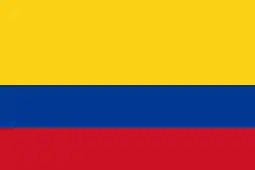Emigration from the United States
Emigration from the United States is the process where individuals from the United States move to live in other countries, creating an American diaspora (overseas Americans). The process is the reverse of the immigration to the United States. The United States does not keep track of emigration, and counts of Americans abroad are thus only available based on statistics kept by the destination countries.
History
Due to the flow of people back and forth between the United Kingdom and its colonies, as well as between the colonies, there has been an American diaspora of a sort since before the United States was founded. During the American Revolutionary War, a number of American Loyalists relocated to other countries, chiefly Canada and the United Kingdom. Residence in countries outside the British Empire was unusual, and usually limited to the well-to-do, such as Benjamin Franklin, who was able to self-finance his trip to Paris as an American diplomat.
19th century
Thanks to the increase of whalers and clipper ships, Americans began to travel all over the world for business reasons.
The early 19th century also saw the beginning of overseas religious missionary activity, such as with Adoniram Judson in Burma.
The middle of the 19th century saw the immigration of many New Englanders to Hawaii, as missionaries for the Congregational Church, and as traders and whalers. The American population eventually overthrew the government of Hawaii, leading to its annexation by the United States.
During this time former slaves also migrated to Liberia, becoming the Americo-Liberians, who dominated the country for most of its history.
After the American Civil War, thousands of Southerners moved to Brazil, where slavery was still legal at the time.[42]
In Asia, the American government made efforts to secure special privileges for its citizens. This began with the Treaty of Wanghia in China in 1844. It was followed by the expedition of Commodore Perry to Japan 10 years later, and the United States–Korea Treaty of 1882. American traders began to settle in those countries.
Early 20th century
Many Americans migrated to the Philippines after it became a U.S. territory following the Philippine–American War.
Cecil Rhodes created the Rhodes Scholarship in 1902 to encourage greater cooperation between the United States, the British Empire, and Germany by allowing students to study abroad.
Interwar period
In the period between the First and Second World Wars, many Americans, particularly writers such as Ernest Hemingway, Gertrude Stein, and Ezra Pound, migrated to Europe to take part in the cultural scene.
European cities like Amsterdam, Berlin, Copenhagen, Paris, Prague, Rome, Stockholm, and Vienna came to host a large number of Americans. Many Americans, typically those who were idealistic and/or involved in left-leaning politics, also participated in the Spanish Civil War (mainly supporting the Republicans against the Nationalists) in Spain while they lived in Madrid and elsewhere.
Other Americans returned home to the countries of their origin, including the parents of American author/illustrator Eric Carle, who returned to Germany. Thousands of Japanese Americans were unable to return to the United States, after the Attack on Pearl Harbor.[43]
Cold War
During the Cold War, Americans became a permanent fixture in many countries with large populations of American soldiers, such as West Germany and South Korea.
The Cold War also saw the development of government programs to encourage young Americans to go abroad. The Fulbright Program was established in 1946 to encourage cultural exchange, and the Peace Corps was created in 1961 both to encourage cultural exchange and a civic spirit of volunteerism.
With the formation of the state of Israel, over 100,000 Jews made aliyah to the holy land, where they played a role in the creation of the state. Other Americans traveled to countries like Lebanon, again to take place in the cultural scene.
During the Vietnam War, about 100,000 American men went abroad to avoid conscription, 90% of them going to Canada.[44] European nations, including neutral states like Denmark, Norway, Sweden, and Switzerland, offered asylum to thousands of American expatriates who refused to fight.
A small number of Americans abandoned the country for political reasons, defecting to the Soviet Union, Cuba, or other countries, such as Miguel d'Escoto Brockmann, and sixties radicals such as Joanne Chesimard, Pete O'Neal, Eldridge Cleaver, and Stokely Carmichael.
During this period Americans continued to travel abroad for religious reasons, such as Richard James, inventor of the Slinky, who went to Bolivia with the Wycliffe Bible Translators, and the Peoples Temple establishment of Jonestown in Guyana.
After the Cold War
The opening of Eastern Europe, Central Europe, and Central Asia after the Cold War provided new opportunities for American businesspeople. Additionally, with the global dominance of the United States in the world economy, the ESL industry continued to grow, especially in new and emerging markets. Many Americans also take a year abroad during college, and some return to the country after graduation.
Iraq War deserters sought refuge mostly in Canada and Europe, and NSA whistleblower Edward Snowden escaped to Russia.[45][46]
Increasing numbers of Americans retire abroad due to financial setbacks resulting from the 2008 financial crisis.[47]
Young Americans facing a tough job market due to the recession are also increasingly open to working abroad.[48]
According to a Gallup poll from January 2019, 16% of Americans, including 40% of women under the age of 30, would like to leave the United States.[49]
Reasons for emigrating
There are many reasons why Americans emigrate from the United States. Economic reasons include job or business opportunities, or a higher standard of living in another country. Others emigrate due to marriage or partnership to a foreigner, for religious or humanitarian purposes, or to seek adventure or experience a different culture.[50] Many decide to retire abroad seeking a lower cost of living, especially more affordable health care.[51][52] Immigrants to the United States may decide to return to their countries of origin to be with family members. Other reasons include political insatisfaction, safety concerns and cultural issues such as racism.[53] Some Americans may also emigrate to evade legal liabilities; a common past case was evasion of mandatory military service.
In addition to Americans who choose to emigrate as adults, many children are born in the United States to foreign temporary workers or international students and naturally move with their parents when they return to their countries of origin. Due to their acquisition of U.S. citizenship by birth but no significant connection to the country, they are sometimes called "accidental Americans".[54]
Destinations with facilitated access
In addition to U.S. territories, U.S. citizens have the right to reside in the Marshall Islands, Micronesia and Palau due to a Compact of Free Association between the United States and each of these countries. They may also freely move to Svalbard due to its open migration policy, as long as they are able to obtain housing and means of support there.[55][56]
Americans with ancestors from certain countries may be able to claim nationality and therefore move there freely. Similarly, American Jews may move to Israel under its Law of Return.
The USMCA (and previously NAFTA) allows U.S. citizens to work in Canada and Mexico in business or in certain professions, with few restrictions.[57] However, to obtain permanent residence they must still satisfy the regular immigration requirements in these countries.
Net effect
The United States is a net immigration country, meaning more people arrive in the U.S. than leave it. There is a scarcity of official records in this domain.[58] Given the high dynamics of the emigration-prone groups, emigration from the United States remains indiscernible from temporary country leave.
Citizenship
Anyone born in the United States, with the sole exception of those born to foreign diplomats, acquires U.S. citizenship at birth. Those born abroad to at least one American parent also acquire U.S. citizenship if the parent had lived in the United States for a certain number of years. Immigrants to the United States may also become U.S. citizens by naturalization.
In the past it was possible for Americans abroad to lose U.S. citizenship involuntarily, but after Supreme Court decisions such as Afroyim v. Rusk and Vance v. Terrazas, along with corresponding changes in U.S. law, they can only lose U.S. citizenship in a very limited number of ways, most commonly by expressly renouncing it at a U.S. embassy or consulate.
Historically, few Americans renounced U.S. citizenship per year, but the numbers drastically increased after 2010 when the U.S. government enacted the Foreign Account Tax Compliance Act, requiring foreign banks to report information on American holders of bank accounts located outside the United States. More than 3,000 Americans renounced U.S. citizenship in 2013, many citing the financial disclosure requirements and difficulty in finding banks willing to accept them as customers.[59] More than 5,000 renounced in 2016, and more than 6,000 did in 2020.[60]
Issues
One of the biggest issues with the American diaspora is double taxation. Unlike almost all countries in the world, the United States taxes its citizens even if they do not live in the country. The foreign earned income exclusion mitigates double taxation on income from work, but the Internal Revenue Code treats ordinary foreign savings plans held by residents of foreign countries as if they were offshore tax avoidance instruments and requires extensive asset reporting, resulting in significant costs for Americans at all income levels to comply with filing requirements even when they owe no tax.[61][62][63] Even Canada's Registered Disability Savings Plan falls under such reporting requirements.[64] The most prominent piece of legislation which has attracted the ire of Americans abroad is the Foreign Account Tax Compliance Act (FATCA). Disadvantages stemming from FATCA, such as hindering career advancement overseas, may decrease the number of Americans in the diaspora in future years. The problem is so severe that some Americans have addressed it by renouncing or relinquishing their U.S. citizenship.[65] Since 2013, the number of people giving up US citizenship has risen to a new record each year, with an unprecedented 5,411 in 2016, up 26% from the 4,279 renunciations in 2015.[66][67][68]
Statistics
There are no exact figures on how many Americans live abroad. The United States Census Bureau does not count Americans abroad, and individual U.S. embassies offer only rough estimates.
In 1999, a Department of State estimate suggested that the number of Americans abroad may be between 3 million and 6 million.[61][69] In 2016, the agency estimated 9 million U.S. citizens were living abroad,[1] but these numbers are highly open to dispute as they often are unverified and can change rapidly.[70]
According to the Federal Voting Assistance Program (FVAP), the Department of State's estimates are inflated on purpose as their purpose is to prepare for emergencies.[71] FVAP makes its own detailed estimates of the number of U.S. citizens abroad, by region and by country, and of those who are of voting age, based on a variety of sources such as censuses of other countries and U.S. tax and social security records. In 2018, it estimated about 4.8 million U.S. citizens abroad, of whom about 2.9 million were of voting age.[72] FVAP's estimates also fluctuate significantly, for example it had estimated about 5.5 million in 2016.[73]
The United Nations estimates the number of migrants by origin and destination of all countries and territories. In 2019, the organization estimated that about 3.2 million people from the United States were living elsewhere.[74] This number is mostly based on country of birth recorded in censuses, so it does not include U.S. citizens who were not born in the United States, such as those who acquired U.S. citizenship by descent or naturalization.
One indicator of the U.S. citizen population overseas is the number of Consular Reports of Birth Abroad requested by U.S. citizens from a U.S. embassy or consulate as a proof of U.S. citizenship of their children born abroad. The Bureau of Consular Affairs reported issuing 503,585 such documents over the decade 2000–2009. Based on this, and on some assumptions about the family composition and birth rates, some authors estimate the U.S. civilian population overseas as between 3.6 and 4.3 million.[75]
Sizes of certain subsets of U.S. citizens living abroad can be estimated based on statistics published by the Internal Revenue Service (IRS). U.S. citizens with income above a certain level are required to file a U.S. income tax regardless of where they reside. During 2019, the IRS recorded about 739,000 U.S. tax returns filed with a foreign address, representing about 1.3 million people including spouses and dependents.[76] Other indicators are the number of U.S. tax returns with a partial exclusion on income from work abroad (about 476,000 in 2016[77]) and those reporting foreign income other than passive income (about 1.5 million in 2016[78]), but not all of these were from people actually residing abroad full-time.
Estimates by country
The list below is of the main countries hosting American populations. Those shown first with exact counts are enumerations of Americans who have immigrated to those countries and are legally resident there, does not include those who were born there to one or two American parents, does not necessarily include those born in the U.S. to parents temporarily in the U.S. and moved with parents by right of citizenship rather than immigration, and does not necessarily include temporary expatriates. In all other cases, starting with Israel, the figures are estimates of part-time U.S. resident Americans and expatriates alike.
 Mexico – 899,311 United States-born residents of Mexico (2017)[79]
Mexico – 899,311 United States-born residents of Mexico (2017)[79] European Union – 800,000 (2013; all EU countries combined)
European Union – 800,000 (2013; all EU countries combined).svg.png.webp) Canada – 738,203 (2011)[80]
Canada – 738,203 (2011)[80] India – 700,000 according to a press release from the White House on 12/06/2017[4]
India – 700,000 according to a press release from the White House on 12/06/2017[4] Philippines – 600,000 (2015)[81]
Philippines – 600,000 (2015)[81] Brazil – 260,000[82]
Brazil – 260,000[82] Israel – 185,000
Israel – 185,000  Italy – 170,000 to 200,000
Italy – 170,000 to 200,000  United Kingdom – 158,000 (2013)[83]
United Kingdom – 158,000 (2013)[83] South Korea – 140,222 (2016)[84][85]
South Korea – 140,222 (2016)[84][85] Germany – 107,755 (2013)[86]
Germany – 107,755 (2013)[86] France – 100,619 (2008)[87]
France – 100,619 (2008)[87].svg.png.webp) Australia – 90,100 (2011)[88]
Australia – 90,100 (2011)[88] Japan – 88,000 (2011)[89]
Japan – 88,000 (2011)[89] Dominican Republic – 82,000
Dominican Republic – 82,000  China – 71,493 (2010, Mainland China only)[90][91]
China – 71,493 (2010, Mainland China only)[90][91] Spain – 63,362
Spain – 63,362  Colombia – 60,000[92]
Colombia – 60,000[92] Hong Kong – 60,000[91]
Hong Kong – 60,000[91] Pakistan – 52,486[20]
Pakistan – 52,486[20] United Arab Emirates – 40,000
United Arab Emirates – 40,000  Republic of China (Taiwan) – 38,000
Republic of China (Taiwan) – 38,000.svg.png.webp) Belgium – 36,000
Belgium – 36,000  Saudi Arabia – 36,000
Saudi Arabia – 36,000  Switzerland – 32,000
Switzerland – 32,000  Poland – 31,000 to 60,000
Poland – 31,000 to 60,000  Lebanon – 25,000[93]
Lebanon – 25,000[93] Panama – 25,000[94]
Panama – 25,000[94] Netherlands – 20,769 (2019)[95]
Netherlands – 20,769 (2019)[95] New Zealand – 17,748 (2006)[96]
New Zealand – 17,748 (2006)[96] Sweden – 16,555 (2009)[97]
Sweden – 16,555 (2009)[97] Austria – 15,000
Austria – 15,000  Hungary – 15,000
Hungary – 15,000  Singapore – 15,000[91]
Singapore – 15,000[91] Ireland – 12,475 (2006)[98]
Ireland – 12,475 (2006)[98] Argentina – 10,552
Argentina – 10,552  Peru — 10,409 (2017)[99]
Peru — 10,409 (2017)[99] Chile – 10,000
Chile – 10,000 Denmark – 9,634 (2018)[100]
Denmark – 9,634 (2018)[100] Czech Republic – 9,510 (2019; 7,131 have residence permit for 12+ months)[101]
Czech Republic – 9,510 (2019; 7,131 have residence permit for 12+ months)[101] Costa Rica – 9,128[102] to 50,000[103]
Costa Rica – 9,128[102] to 50,000[103] Norway – 8,013 (2012)[104]
Norway – 8,013 (2012)[104] Malaysia – 8,000[91]
Malaysia – 8,000[91] Ecuador – 7,500
Ecuador – 7,500 Finland – 5,576[105]
Finland – 5,576[105] Guatemala – 5,417 (2010)[106]
Guatemala – 5,417 (2010)[106] Uruguay – 3,000[107]
Uruguay – 3,000[107] Portugal – 2,228 (2008)[108]
Portugal – 2,228 (2008)[108] Russia – at least 2,008[109] up to 6,200[110]
Russia – at least 2,008[109] up to 6,200[110]
See also
- Immigration to the United States
- American Canadians
- American Mexicans
- Americans in Cuba
- American Brazilians
- Americans in the United Kingdom
- American Australians
- American New Zealanders
- Americans in France
- Americans in the Philippines
- Americans in Japan
- Americo-Liberian people
- American settlement in the Philippines
- Lost Generation
- Mexicans of American descent
- Confederados of Brazil
- Taxation of non resident Americans
- American Citizens Abroad
- Taxation of United States persons
- International taxation
- Relinquishment of United States nationality
- Samaná English
- List of Americans who married international nobility
References
- "CA By the Numbers" (PDF). U.S. Department of State. January 2016. Archived from the original (PDF) on 2016-06-16.
- "People live in Mexico, INEGI, 2010".
- Smith, Dr. Claire M. (August 2010). "These are our Numbers: Civilian Americans Overseas and Voter Turnout" (PDF). OVF Research Newsletter. Overseas Vote Foundation. Archived from the original (PDF) on October 24, 2013. Retrieved December 11, 2012.
Previous research indicates that the number of U.S. Americans living in Mexico is around 1 million, with 600,000 of those living in Mexico City.
- "Fact Sheet: The United States and India — Prosperity Through Partnership". White House. 26 June 2017. Retrieved 28 June 2017.
- "BiB - Bundesinstitut für Bevölkerungsforschung - Pressemitteilungen - Archiv 2017 - Zuwanderung aus außereuropäischen Ländern fast verdoppelt". www.bib-demografie.de.
- https://dr1.com/forums/threads/200-000-us-citizens-live-in-dominican-republic.102079/. Missing or empty
|title=(help) - Daphna Berman (January 23, 2008). "Need an appointment at the U.S. Embassy? Get on line!". Haaretz. Retrieved December 11, 2012.
According to estimates, some 200,000 American citizens live in Israel and the Palestinian territories.
- Michele Chabin (March 19, 2012). "In vitro babies denied U.S. citizenship". USA Today. Jerusalem. Retrieved December 11, 2012.
Most of the 200,000 U.S. citizens in Israel have dual citizenship, and fertility treatments are common because they are free.
- "Americans in France". Embassy of the United States, Paris. United States Department of State. Archived from the original on April 18, 2015. Retrieved April 26, 2015.
Today, although no official figure is available it is estimated that over 150,000 American citizens reside in France, making France one of the top 10 destinations for American expatriates.
- "Population by Country of Birth and Nationality Report, August 2012" (PDF). Office for National Statistics. August 30, 2012. Retrieved December 11, 2012.
- Simon Rogers (May 26, 2011). "The UK's foreign-born population: see where people live and where they're from". The Guardian. Retrieved February 17, 2013.
County of birth and county of nationality. United States of America 197 143
- Mapa de Migraciones. Mapa de Migraciones (Origen = Estados Unidos de America (EE UU); Destino = Puerto Rico. El País. Madrid, Spain. 2014. Accessed 9 October 2020. Quote: La base de datos de la División de Población del Departamento de Asuntos Económicos y Sociales de Naciones Unidas recoge el número de extranjeros residentes en cada país a partir de 1990. Se trata de una estimación basada en los datos oficiales aportados por los Estados que registran tanto a los ciudadanos nacidos en otros países como a los que tienen nacionalidad extranjera, incluyendo a los residentes en situación irregular. La variación entre una década y otra refleja los cambios en las comunidades de inmigrantes y en los flujos migratorios. El dato de “Otros” corresponde al número de extranjeros residentes del que no ha sido declarada la nacionalidad.(English: The database of the Division of Population of the Department of Economic and Financial Affairs of the United Nations collects the nunber of foreign residents in each country starting in 1990. It consists of an estimate based on official facts provided by the States that track citizens born in other countries as well as those of foreign nationality, including residents with an irregular status. The change between one decade and another reflects the changes in immigrant communities and in migratory flows. The field "Otros" (i.e., Others) corresponds to the number of foreign residents with an unknown nationality.)
- "Background Note: Costa Rica". Bureau of Western Hemisphere Affairs. United States Department of State. April 9, 2012. Retrieved December 11, 2012.
Over 130,000 private American citizens, including many retirees, reside in the country and more than 700,000 American citizens visit Costa Rica annually.
- "U.S. Citizen Services". Embassy of the United States Seoul, Korea. United States Department of State. Archived from the original on November 30, 2012. Retrieved December 11, 2012.
This website is updated daily and should be your primary resource when applying for a passport, Consular Report of Birth Abroad, notarization, or any of the other services we offer to the estimated 120,000 U.S. citizens traveling, living, and working in Korea.
"North Korea propaganda video depicts invasion of South Korea, US hostage taking". Advertiser. Agence France-Presse. March 22, 2013. Retrieved March 23, 2013.According to official immigration figures, South Korea has an American population of more than 130,000 civilians and 28,000 troops.
- https://usatoday30.usatoday.com/news/world/2005-11-17-china-guide_x.htm
- "Brazil (11/30/11)". Previous Editions of Brazil Background Note. United States Department of State. November 30, 2012. Retrieved December 11, 2012.
The consular section of the embassy, the consulates, and the consular agents provide vital services to the estimated 70,000 U.S. citizens residing in Brazil.
- "Hong Kong (10/11/11)". Previous Editions of Hong Kong Background Note. United States Department of State. October 11, 2011. Retrieved December 11, 2012.
There are some 1,400 U.S. firms, including 817 regional operations (288 regional headquarters and 529 regional offices), and over 60,000 American residents in Hong Kong.
- "ibid, Ancestry (full classification list) by Sex – Australia". Retrieved October 19, 2014.
- "平成29年度末 在留外国人確定値" (PDF). Ministry of Justice, . Annual Report of Statistics on Legal Migrants. National Institute of Population and Social Security Research. 2018. Archived from the original (PDF) on March 27, 2018. Retrieved April 14, 2018.
- Gishkori, Zahid (30 July 2015). "Karachi has witnessed 43% decrease in target killing: Nisar". The Express Tribune. Retrieved 3 August 2017.
As many as 116,308 Afghan nationals are living as immigrants in the country, higher than any other country,” Nisar told the House. Besides Afghans, 52,486 Americans, 79,447 British citizens and 17,320 Canadians are residing in the country, the interior minister added.
- Kelly Carter (May 17, 2005). "High cost of living crush Americans' dreams of Italian living". USA Today. Positano, Italy. Retrieved December 17, 2012.
Nearly 50,000 Americans lived in Italy at the end of 2003, according to Italy's immigration office.
- "UAE´s population – by nationality". BQ Magazine. April 12, 2015. Archived from the original on July 11, 2015. Retrieved June 13, 2015.
- McKinley Jr., James C. (January 17, 2010). "For 45,000 Americans in Haiti, the Quake Was 'a Nightmare That's Not Ending'". The New York Times. Retrieved February 27, 2015.
- "SAUDI-U.S. TRADE". Commerce Office. Royal Embassy of Saudi Arabia in Washington D.C. Archived from the original on September 13, 2012. Retrieved February 14, 2012.
Furthermore, there are approximately 40,000 Americans living and working in the Kingdom.
- "Argentina (03/12/12)". Previous Editions of Argentina Background Note. United States Department of State. March 12, 2012. Retrieved December 24, 2012.
The Embassy's Consular Section monitors the welfare and whereabouts of some 37,000 U.S. citizen residents of Argentina and more than 500,000 U.S. tourists each year.
- "Spanish National Institute of Statistics - Foreign Population by Nationality and Sex, Jan 1st 2018" (in Spanish). National Institute of Statistics, Spanish Government. 2018. Retrieved June 14, 2018.
Search for "Sexo = Ambos sexos" (both sexes), "Comunidades y provincias = TOTAL ESPAÑA" (Spain total) and "Nacionalidad = Estados Unidos de América".
- "Statistics Norway – Persons with immigrant background by immigration category and country background. January 1, 2010". Retrieved October 19, 2014.
- "Bahamas, The (01/25/12)". Previous Editions of Panama Background Note. United States Department of State. January 25, 2012. Retrieved December 29, 2012.
The countries share ethnic and cultural ties, especially in education, and The Bahamas is home to approximately 30,000 American residents.
- Kate King (July 18, 2006). "U.S. family: Get us out of Lebanon". CNN. Archived from the original on March 6, 2012. Retrieved February 14, 2012.
About 350 of the estimated 25,000 American citizens in Lebanon had been flown to Cyprus from the U.S. Embassy in Beirut by nightfall Tuesday, Maura Harty, the assistant secretary of state for consular affairs, told reporters.
- "Panama (03/09)". Previous Editions of Panama Background Note. United States Department of State. March 2009. Retrieved December 17, 2012.
About 25,000 American citizens reside in Panama, many retirees from the Panama Canal Commission and individuals who hold dual nationality.
- "El Salvador (01/10)". United States Department of State. Archived from the original on April 13, 2014. Retrieved April 11, 2014.
More than 19,000 American citizens live and work full-time in El Salvador
- "North Americans: Facts and figures". Te Ara: The Encyclopedia of New Zealand.
- Pollak, Sorcha. "Number with dual Irish nationality soars by nearly 90%". The Irish Times.
- "Honduras (11/23/09)". Previous Editions of Honduras Background Note. United States Department of State. November 23, 2009. Retrieved December 17, 2012.
U.S.-Honduran ties are further strengthened by numerous private sector contacts, with an average of between 80,000 and 110,000 U.S. citizens visiting Honduras annually and about 15,000 Americans residing there.
- "Chile (07/08)". Previous Editions of Chile Background Note. United States Department of State. July 2008. Retrieved December 17, 2012.
The Consular Section of the Embassy provides vital services to the more than 12,000 U.S. citizens residing in Chile.
- "06-08 外僑居留人數 Foreign Residents". National Immigration Agency, MOI. Department of Statistics, Ministry of the Interior. 2011. Archived from the original on January 6, 2007. Retrieved December 17, 2012.
- "STATISTIK AUSTRIA - Bevölkerung nach Staatsangehörigkeit und Geburtsland". Retrieved October 19, 2014.
- "Bermuda". Previous Editions of Bermuda Background Note. United States Department of State. December 9, 2011. Retrieved December 29, 2012.
An estimated 8,000 registered U.S. citizens live in Bermuda, many of them employed in the international business community.
- Tatiana Morales (August 2, 2009). "Americans in Kuwait: When To Go?". CBS News. Retrieved December 17, 2012.
There are about 8,000 Americans who live in Kuwait.
- "Guatemala (07/08)". Previous Editions of Chile Background Note. United States Department of State. July 2008. Archived from the original on 2017-03-23. Retrieved 17 December 2012.
The Consular Section of the Embassy provides vital services to the more than 12,000 U.S. citizens residing in Chile.
- "7 of the Top Places U.S. Expats Are Living in Latin America (and Why)". May 2, 2014.
- The American Confederacy is still alive in a small Brazilian city called Americana, Business Insider, May 7, 2017.
- Mary Granfield (6 August 1990). "Hiroshima's Lost Americans". People. Time Inc. Retrieved 7 January 2015.
n the summer of 1945, there were 30,000 Japanese-Americans in Japan. Many were kibei, American-born children whose immigrant parents had sent them back to Japan before the war to receive a traditional education. Others had come to visit relatives. After the war broke out in 1941, they were unable to return to the U.S.; 110,000 of their American relatives, most of them on the West Coast, were confined in internment camps.
- "President Carter pardons draft dodgers". History.com. Retrieved 31 January 2013.
- Patty Winsa (February 8, 2015). "More U.S. soldiers could be sent back for court martial on desertion charges". The Star.
- "Edward Snowden: Leaks that exposed US spy programme". BBC. January 17, 2014.
- Anna Robaton (November 20, 2013). "Feeling pinch back home, U.S. retirees pursue the American Dream abroad". CNBC.
- Jonathan House (October 6, 2014). "Americans Don't Fancy Jobs Abroad. Oh, Except Millennials". Wall Street Journal.
- "Record Numbers of Americans Want to Leave the U.S." Gallup. 2019-01-04.
- Americans Abroad: Escaping or Enhancing Life?, UConn Today, August 7, 2020.
- Dreaming of retiring abroad? Here’s what you need to know, CNBC, September 14, 2020.
- Many Americans move abroad for health care—should you?, MarketWatch, March 12, 2019.
- Ghana to black Americans: Come home. We’ll help you build a life here., Washington Post, July 4, 2020.
- Joe Costanzo, Amanda Klekowski von Koppenfels (May 17, 2013). "Counting the Uncountable: Overseas Americans". Migration Policy Institute.
- Entry and residence, Governor of Svalbard.
- Immigrants warmly welcomed, Al Jazeera, July 4, 2006.
- Chapter 16, Temporary entry for business persons, Agreement between the United States of America, the United Mexican States, and Canada, Office of the United States Trade Representative.
- http://unstats.un.org/unsd/Demographic/meetings/egm/migrationegm06/DOC%2019%20ILO.pdf#page=2
- "Why More Americans Are Renouncing U.S. Citizenship". Retrieved 12 August 2017.
- 2020 is a record year for Americans giving up citizenship, according to N.Y. accountants group, Penn Live, October 29, 2020.
- "The American Diaspora". Esquire. 26 September 2008. Retrieved 17 April 2011.
- "Costing More Over There", The Economist, 22 June 2006, accessed 17 April 2011
- Leckie, Gavin F. (November 2011). "The Accidental American". Trusts & Estates: 58. Retrieved 2014-11-03.
- Hildebrandt, Amber (2014-01-13). "U.S. FATCA tax law catches unsuspecting Canadians in its crosshairs". Canadian Broadcasting Corporation. Retrieved 2015-07-17.
- Richard Rubin. "Americans Living Abroad Set Record for Giving Up Citizenship". Bloomberg. Retrieved August 23, 2015.
- Wintour, Patrick (February 9, 2017). "Boris Johnson among record number to renounce American citizenship in 2016". the Guardian.
- "Americans Forfeiting Citizenship at Record Rates With No Tax Relief in Sight".
- Millward, David (February 11, 2017). "Number of Americans renouncing citizenship reaches record high" – via www.telegraph.co.uk.
- "Stats" (PDF). unstats.un.org.
- Bill Masterson (2000), How Many Americans Really Live in Mexico? And Who Cares, Anyway?, peoplesguide.com
- Overseas Citizen Population Analysis Report, Federal Voting Assistance Program. "In previous years, the Department of State has released estimates of the number of overseas civilians; however, these numbers are used for contingency operations and appropriately result in an overestimation."
- 2018 Overseas Citizen Population Analysis Report, Federal Voting Assistance Program, July 2020.
- 2016 Overseas Citizen Population Analysis Report, Federal Voting Assistance Program, September 2018.
- International migrant stock 2019, United Nations Department of Economic and Social Affairs, Population Division.
- These are our Numbers: Civilian Americans Overseas and Voter Turnout Archived October 24, 2013, at the Wayback Machine, By Dr. Claire M. Smith (Originally published: OVF Research Newsletter, vol. 2, issue 4 (Aug), 2010)
- Table 2. Individual Income and Tax Data, by State and Size of Adjusted Gross Income, Tax Year 2018, Internal Revenue Service, August 2020.
- Table 1. Individual Income Tax Returns With Form 2555: Sources of Income, Deductions, Tax Items, and Foreign-Earned Income and Exclusions, by Size of Adjusted Gross Income, Tax Year 2016, Internal Revenue Service, October 2019.
- Table 5. Individual Income Tax Returns With Form 1116: Foreign-Source Income, Deductions, and Taxes, by Type of Income, Tax Year 2016, Internal Revenue Service, October 2019.
- "Table 1: Total migrant stock at mid-year by origin and by major area, region, country or area of destination, 2017". United Nations, Department of Economic and Social Affairs, Population Division. Retrieved 17 August 2018.
- Canada, Government of Canada, Statistics. "2011 National Household Survey: Data tables – Citizenship (5), Place of Birth (236), Immigrant Status and Period of Immigration (11), Age Groups (10) and Sex (3) for the Population in Private Households of Canada, Provinces, Territories, Census Metropolitan Areas and Census Agglomerations, 2011 National Household Survey". www12.statcan.gc.ca. Retrieved 12 August 2017.
- "Why the Philippines Is America's Forgotten Colony". Retrieved 12 August 2017.
- US Embassy in Brazil US Embassy in Brazil. Retrieved March 29, 2020.
- 2013 - Office for National Statistics
- "U.S. Citizen Services". Embassy of the United States Seoul, Korea. United States Department of State. Archived from the original on November 30, 2012. Retrieved December 11, 2012.
This website is updated daily and should be your primary resource when applying for a passport, Consular Report of Birth Abroad, notarization, or any of the other services we offer to the estimated 120,000 U.S. citizens traveling, living, and working in Korea.
"North Korea propaganda video depicts invasion of South Korea, US hostage taking". Advertiser. Agence France-Presse. March 22, 2013. Retrieved March 23, 2013.According to official immigration figures, South Korea has an American population of more than 130,000 civilians and 28,000 troops.
- No. of Foreign Nationals Residing in Korea Exceeds 2 Mil. in 2016 No-of-foreign-nationals-residing-in-korea-exceeds-2-mil-in-2016 (The Korea Economic Daily)
- https://www.destatis.de/DE/Publikationen/Thematisch/Bevoelkerung/MigrationIntegration/AuslaendBevoelkerung2010200137004.pdf?__blob=publicationFile
- "Résultats de la recherche - Insee". insee.fr. Retrieved 12 August 2017.
- . Australian Bureau of Statistics. 2011. Last accessed 22 July 2014.
- (http://www.japanmattersforamerica.org/2011/05/census-counts-japanese-in-us/)
- 2010 Chinese Census (from Wikipedia article Demographics of the People's Republic of China)
- "Subscribe to read". Financial Times. Retrieved 12 August 2017. Cite uses generic title (help)
- "Colombia (03/28/13)". Previous Editions of Hong Kong Background Note. United States Department of State. 28 March 2013. Archived from the original on 20 April 2013. Retrieved 23 April 2013.
Based on Colombian statistics, an estimated 60,000 U.S. citizens reside in Colombia and 280,000 U.S. citizens travel, study and do business in Colombia each year.
- see List of countries with foreign nationals in Lebanon
- U.S. Relations With Panama
- "CBS StatLine". statline.cbs.nl. Retrieved 9 May 2020.
- 2006 Census, Statistics New Zealand Archived July 24, 2011, at the Wayback Machine
- http://www.scb.se/statistik/_publikationer/BE0101_2009A01_BR_03_BE0110TAB.pdf
- File:NonnationalsIreland2006.png
- Instituto Nacional de Estadística e Informática (October 2018). "Perú: Estadísticas de la Emigración Internacional de Peruanos e Inmigración de Extranjeros, 1990 – 2017" (PDF). Organización Internacional para las Migraciones (OIM). Ministerio de Relaciones Exteriores - RREE. 1: 85 – via Database.
- "Statistikbanken". statistikbanken.dk. Retrieved 12 August 2017.
- Foreigners, total by citizenship as at 31 December 2018 1). Czech Statistical Office.
- "Archived copy" (PDF). Archived from the original (PDF) on 2010-11-27. Retrieved 2010-01-30.CS1 maint: archived copy as title (link)
- "Costa Rica". Retrieved 12 August 2017.
- "Archived copy". Archived from the original on 2013-02-06. Retrieved 2013-02-06.CS1 maint: archived copy as title (link)
- "Väestö 31.12. muuttujina Maakunta, Syntymävaltio, Ikä, Sukupuoli, Vuosi ja Tiedot". Tilastokeskuksen PX-Web tietokannat. Retrieved 2020-06-15.
- (in Spanish) Perfil Migratorio de Guatemala Archived 2016-03-05 at the Wayback Machine Organización Internacional para las Migraciones (OIM) (2012)
- "Immigration to Uruguay" (PDF) (in Spanish). INE. Archived from the original (PDF) on 16 August 2013. Retrieved 6 March 2013.
- "Statistics Portugal". ine.pt. Retrieved 12 August 2017.
- Russian Census (2002), Basic Result Archived July 19, 2011, at the Wayback Machine: table 4.1. National composition of population, table 4.5. Population by citizenship, table 8.3. Population stayed temporarily on the territory of the Russian Federation by country of usual residence and purpose of arrival
- Federal State Statistics Service, table 5.9. International Migration: in Russian, in English
External links
- The American Diaspora, Esquire, 26 September 2008.
- Jones, Chris. The New American. Esquire, 23 September 2008.
- Sappho, Paul. A Looming American Diaspora, Harvard Business Review, 2009.
- Sullivan, Andrew. The New American Diaspora The Atlantic, 29 September 2009.
- Go East Young Moneyman, The Economist, 14 April 2011.
- William Curtis Donovan. The Coming American Diaspora, 1 October 2008.
